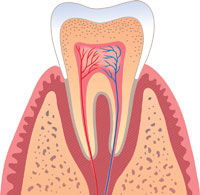Let’s Talk Teeth: An Inside Look at the Different Types and Parts of the Human Tooth
Teeth not only constitute a critical part of a person’s appearance, but they also play an indispensable role in our ability to chew and digest food, as well as speak. Keep reading for a quick overview of the parts of a tooth and the different functions each tooth serves.
A tooth is divided into two basic parts: the crown and the root. The crown is the visible part of the tooth above the gumline. And the root is the part of the tooth that extends below the gumline and attaches the tooth into the jawbone.
Every tooth has a slightly different shape and performs a different function. Here is a brief description of your different teeth and their jobs.
- Incisors: These are the eight teeth in the front and center of your mouth (four on top and four on bottom). Incisors are used to take bites of food and are typically the first teeth to erupt in the mouth.
- Canines: These are your four sharpest teeth, which are used to rip and tear food.
- Premolars: These eight, flat teeth are located on each side of your mouth (two on the upper and two on the lower jaw). Premolars are big and have ridges, which make them perfect for crushing and grinding food.
- Molars: Your 12 molars are even stronger than premolars. Molars are the back teeth that have broad surfaces designed for crushing and grinding food, and they work along with the tongue to help you swallow food after it’s been mashed.
While each type of tooth might look different, they are all comprised of three main types of tissues: pulp, dentin, and enamel.
- Enamel: Enamel is the hard, visible, outermost substance that covers the tooth and protects it from decay.
- Dentin: Dentin is the yellowish, softer layer of the tooth under the enamel that envelops the pulp. Dentin can be attacked by decay if it progresses through the enamel.
- Pulp: The pulp is the soft tissue located in the center of all teeth, containing the nerve tissue and blood vessels. The pulp is how the tooth receives nourishment and transmits signals to the brain.
Your teeth serve different purposes, working together to help you speak, chew and digest your foods. Don’t take your teeth for granted. Pay extra care to your teeth and gums now by brushing and flossing every day, and visit Dental Dimensions regularly for routine check-ups and appointments.



